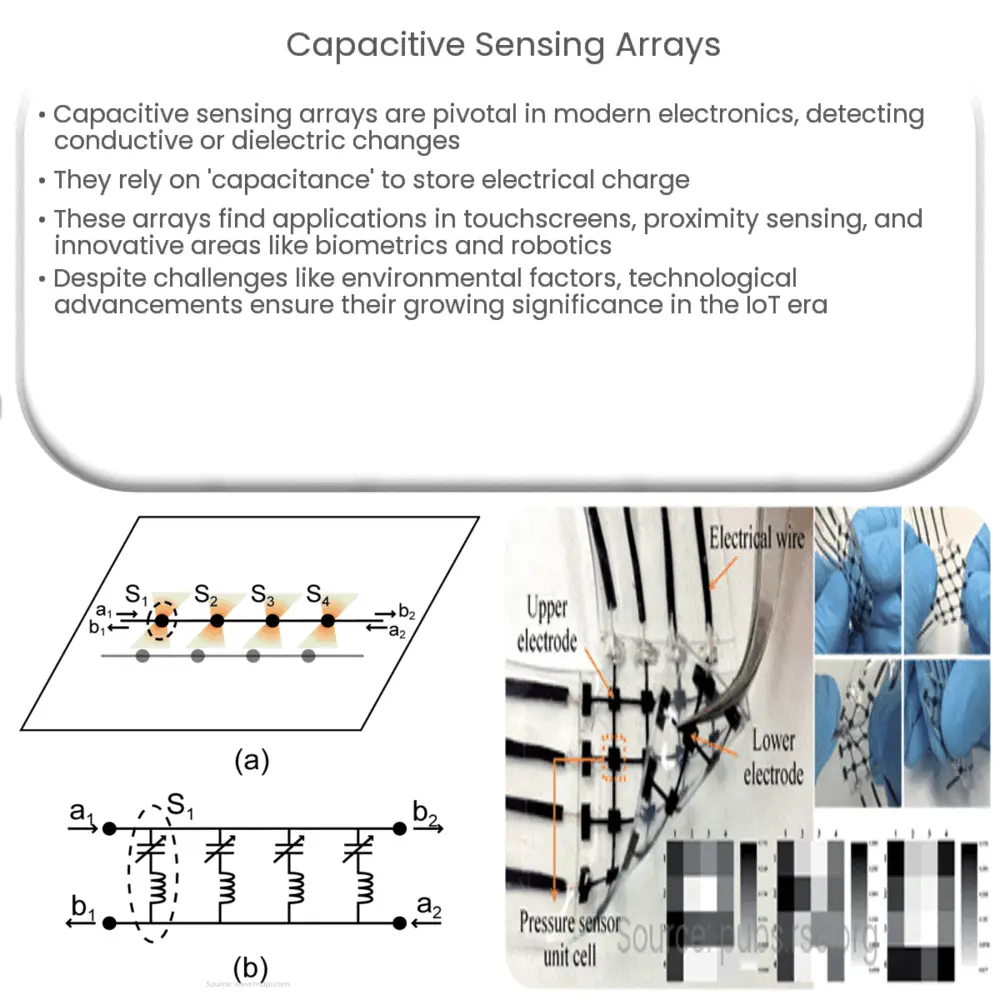Explore the fascinating world of capacitive sensing arrays, their mechanics, diverse applications, challenges, and role in the IoT era.

Introduction to Capacitive Sensing Arrays
Capacitive sensing arrays represent an exciting technology that has found profound application in the world of modern electronics and interface design. With their ability to detect and measure anything that’s conductive or possesses a dielectric different from air, they’ve become a go-to choice in various sectors.
Understanding Capacitive Sensing
At its core, capacitive sensing technology relies on the fundamental concept of ‘capacitance’. Capacitance is an object’s ability to store an electrical charge. In a capacitive sensing scenario, the system detects changes in capacitance when a conductive or dielectric object, such as a human finger, comes near or touches the sensor’s conductive electrode.
What are Capacitive Sensing Arrays?
A capacitive sensing array is a network of capacitive sensors arranged in a particular configuration. Each ‘cell’ or ‘node’ in this array is a capacitive sensor, capable of independent sensing. Combined, they can create high-resolution sensing matrices for various applications.
The Mechanics of Capacitive Sensing Arrays
- Electrode Design: The design of the electrode is a critical aspect in a capacitive sensing array. It can vary depending on the desired sensitivity, resolution, and application.
- Sensing Algorithm: The sensing algorithm plays a significant role in detecting and interpreting changes in capacitance. It converts these changes into usable data for further processing.
- Interpolation: Interpolation enhances the resolution of the capacitive sensing array beyond the physical number of electrodes. This is particularly useful in applications requiring high precision.
The application of capacitive sensing arrays has been widespread in various sectors. Let’s delve into some of these applications and their impact.
Applications of Capacitive Sensing Arrays
- Touch Screens: Capacitive sensing arrays are integral to the operation of touchscreens in smartphones, tablets, and other devices. The arrays can precisely identify and track multiple touch points simultaneously, allowing for multi-touch input.
- Proximity Sensing: These arrays can also be used for proximity sensing in a variety of contexts, such as in vehicles for parking assistance, or in devices to enable touchless interaction.
Capacitive sensing arrays have also found use in other unique applications, like biometric identification, fluid level sensing, and even in the field of robotics.
Unique Applications of Capacitive Sensing Arrays
Alongside the well-established applications in touch screens and proximity sensing, capacitive sensing arrays are increasingly being applied in innovative ways:
- Biometric Identification: Capacitive sensing arrays have been used in fingerprint sensors for biometric identification. The sensor array creates a detailed map of the ridges and valleys of a fingerprint, providing a secure and personalized identification method.
- Fluid Level Sensing: The arrays can measure the level of fluids in a container by detecting changes in capacitance caused by the fluid’s presence. This has significant applications in sectors like automotive and household appliances.
- Robotics: Capacitive sensors can enable tactile sensing in robots, providing them with the ability to feel their environment much like a human skin would. This technology could potentially revolutionize the field of robotics.
Challenges and Future Directions
Despite their remarkable utility, capacitive sensing arrays face challenges in certain conditions. For instance, they can be affected by environmental factors such as temperature and humidity. Moreover, they can potentially register unintended inputs, known as ‘ghost touches’.
However, continuous advancements in technology are helping overcome these challenges. Improvements in algorithm design and hardware components are boosting the sensitivity, accuracy, and robustness of these sensing arrays.
The Role of Capacitive Sensing Arrays in the IoT Era
As we step further into the era of the Internet of Things (IoT), the role of capacitive sensing arrays becomes even more crucial. In an interconnected world where devices continually interact with users and with each other, these arrays provide an efficient and intuitive interface for these interactions.
Conclusion
In conclusion, capacitive sensing arrays are an integral part of our digital world. From the smartphones in our pockets to the burgeoning field of robotics, they offer a reliable and versatile solution for touch and proximity sensing. Despite some challenges, continuous technological advancements promise an even brighter future for capacitive sensing arrays. As we continue to innovate and create more connected devices, the applications and influence of capacitive sensing arrays are only set to grow.

